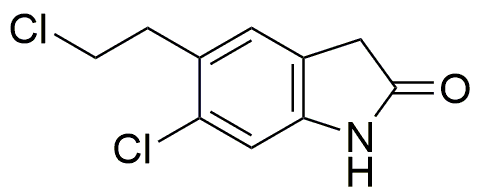6-Chloro-5-(2-chloroethyl)oxindole is widely utilized in research focused on:
- Pharmaceutical Development: This compound serves as a key intermediate in the synthesis of various pharmaceuticals, particularly in the development of anti-cancer agents. Its unique structure allows for modifications that enhance therapeutic efficacy.
- Biochemical Research: Researchers use it to study enzyme interactions and pathways in cellular processes. Its ability to selectively inhibit certain enzymes makes it valuable for understanding disease mechanisms.
- Agricultural Chemistry: It is explored for its potential as a pesticide or herbicide, offering an environmentally friendly alternative to traditional chemicals. This can help in developing safer agricultural practices.
- Material Science: The compound is investigated for its properties in creating novel materials, such as polymers or coatings, which can exhibit improved durability and resistance to environmental factors.
- Analytical Chemistry: It is used as a standard in various analytical techniques, aiding in the detection and quantification of similar compounds in complex mixtures, thus enhancing the accuracy of analytical results.
General Information
Properties
Safety and Regulations
Applications
6-Chloro-5-(2-chloroethyl)oxindole is widely utilized in research focused on:
- Pharmaceutical Development: This compound serves as a key intermediate in the synthesis of various pharmaceuticals, particularly in the development of anti-cancer agents. Its unique structure allows for modifications that enhance therapeutic efficacy.
- Biochemical Research: Researchers use it to study enzyme interactions and pathways in cellular processes. Its ability to selectively inhibit certain enzymes makes it valuable for understanding disease mechanisms.
- Agricultural Chemistry: It is explored for its potential as a pesticide or herbicide, offering an environmentally friendly alternative to traditional chemicals. This can help in developing safer agricultural practices.
- Material Science: The compound is investigated for its properties in creating novel materials, such as polymers or coatings, which can exhibit improved durability and resistance to environmental factors.
- Analytical Chemistry: It is used as a standard in various analytical techniques, aiding in the detection and quantification of similar compounds in complex mixtures, thus enhancing the accuracy of analytical results.
Documents
Safety Data Sheets (SDS)
The SDS provides comprehensive safety information on handling, storage, and disposal of the product.
Product Specification (PS)
The PS provides a comprehensive breakdown of the product’s properties, including chemical composition, physical state, purity, and storage requirements. It also details acceptable quality ranges and the product's intended applications.
Certificates of Analysis (COA)
Search for Certificates of Analysis (COA) by entering the products Lot Number. Lot and Batch Numbers can be found on a product’s label following the words ‘Lot’ or ‘Batch’.
*Catalog Number
*Lot Number
Certificates Of Origin (COO)
This COO confirms the country where the product was manufactured, and also details the materials and components used in it and whether it is derived from natural, synthetic, or other specific sources. This certificate may be required for customs, trade, and regulatory compliance.
*Catalog Number
*Lot Number
Safety Data Sheets (SDS)
The SDS provides comprehensive safety information on handling, storage, and disposal of the product.
DownloadProduct Specification (PS)
The PS provides a comprehensive breakdown of the product’s properties, including chemical composition, physical state, purity, and storage requirements. It also details acceptable quality ranges and the product's intended applications.
DownloadCertificates of Analysis (COA)
Search for Certificates of Analysis (COA) by entering the products Lot Number. Lot and Batch Numbers can be found on a product’s label following the words ‘Lot’ or ‘Batch’.
*Catalog Number
*Lot Number
Certificates Of Origin (COO)
This COO confirms the country where the product was manufactured, and also details the materials and components used in it and whether it is derived from natural, synthetic, or other specific sources. This certificate may be required for customs, trade, and regulatory compliance.

